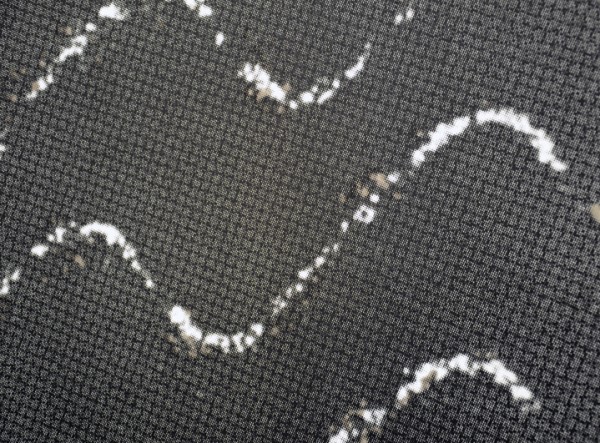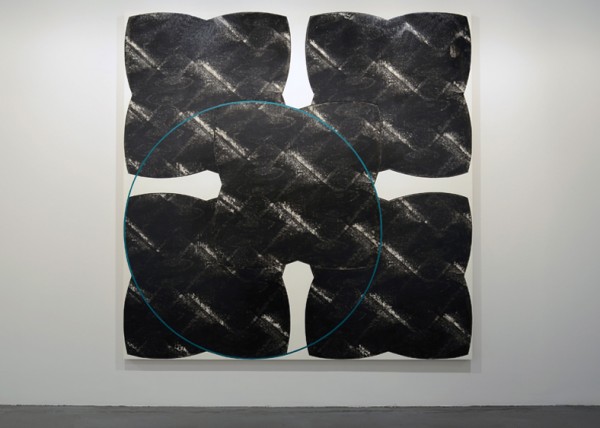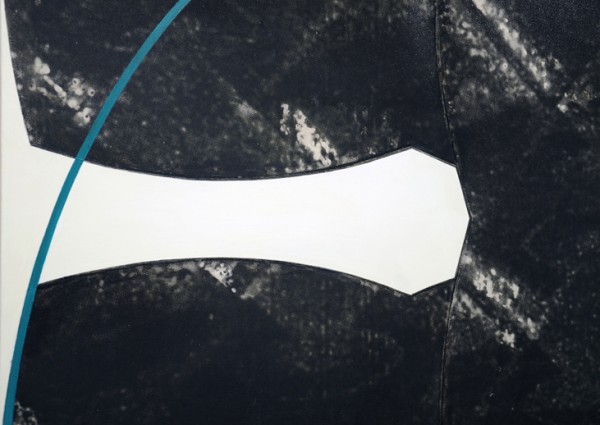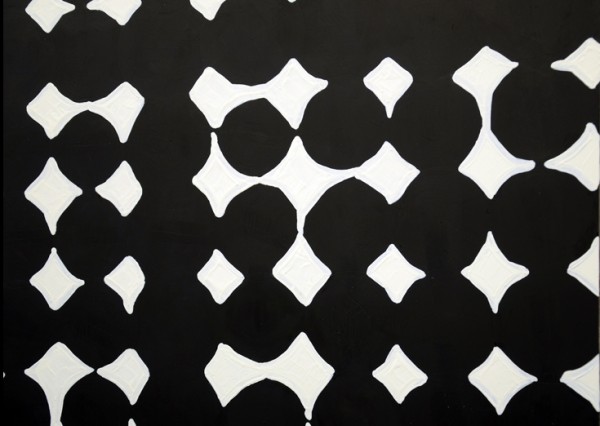
Francis’s Interference (detail), 2012. courtesy of MINUS SPACE, Brooklyn.
To borrow her own words, you can’t really accuse Linda Francis of being obvious. Like anything worth having, her work takes a little bit of unpacking in order to approach its fertile core. Once you get there though, there’s no escaping your involvement. Truly a frenetically active thinker and invested abstractionist, the initially cryptic nature of her work comes from Francis’ interest and understanding of a dizzyingly wide range of academic topics and visual ideas.
Her new show titled We Can Build You is currently open at MINUS SPACE in Dumbo. The work is gorgeous and at first glance quite reductive. In taking time to peel back the layers, one comes to realize there are actually very deep metaphysical notions at work here, ideas that reach forth to tickle every corner of human consciousness — they poke at who we are as a species.
I had the extremely fortunate opportunity to have dinner with Linda in order to discuss the work, and sat across from her lapping it all up while she calmly rolled gem after gem of life altering art knowledge nuggets into my open hands. I have over two hours of recorded conversation to prove it.
The majority of the work in the show comes from an investigation that stems from playing with an image acquired from a friend who was working on a thermodynamic issue for NASA. The image is a close up of the structure of the skin produced to clothe a space shuttle that was in use in the 1990’s. Working with painting hand articulated geometric forms as well as screen prints of images manipulated by computer, the artist creates immersive abstractions that simultaneously reference the structure of the infinitesimal and the galactic in scale.
Repeating and overlaying the image over and over again, Francis creates a body of work that converse with the senses in a variety of stimulating ways. As a skilled geometric abstractionist the first venue of experimentation naturally comes across visually. The best example of this would be the large work on panel to your right as you enter the gallery. One of a number of works in the show titled Interference, it is a large 87 inch square work of oil and screen print on panel.
This painting exhibits an overlay of five quatrefoil shapes of deep black printed ink, one to each corner of the panel and the fifth overlapping each in its position at the center of the image. In a move that Francis repeats throughout the other works of the same title in the show, the source image has been alternately layered until its original appearance is obscured through repetition. The result leaves the viewer with a visual static of hazy white forms peeking through a field of murky black. From here a circle has been painted in vibrantly contrasting green oil paint, returning the eye to the undeniable flatness of the panel while placed to the bottom left of the composition so that its circumference intersects with each of the screen printed constructions at one point of its trajectory or another.
Here the overlay of the source image creates a repetitious visual hum within the layered quatrefoil as the white of the image becomes muddled and takes on new forms in the computer’s attempt to make visual sense of the amalgamation of forms condensed on top of one another.

Francis’s Interference (detail), 2012. courtesy of MINUS SPACE, Brooklyn.
The best part of viewing this work comes not from any of the painterly decisions made by the artist, but from the phenomenological experience of actually laying eyes on the painting in lived time. In a deviation from her usual palette of reds and blacks, the phthalo green circle seems a bit of a departure — until one moves in for a closer look. When focusing on the green paint for any extended period and returning your gaze to the rest of the painting, a momentary flash of red skips across the image in the time your eye takes to adjust from the impression the green pigment has left on your retina. The inescapable power of red seems so deeply ingrained in the artist’s practice that it emerges anyway, even as she retreats to the most distant reaches of the chromatic spectrum.
The work facing you as you walk into the space is one of three long horizontal compositions. Displaying the source image abstracted into sinuous energy waves of white static, this work is also titled Interference. It shows the source image’s ability to be abstracted into multiple visual forms, as it has here become a playful use of sine waves rolling from one side of the wide black expanse to the other. Francis is almost using the computer as an advancement of her brush in this case, working her image into itself in such a way that unaccounted-for geometries emerge, discovered by happenstance and enabled to become the subject of her painterly inquiry.
This injection of static that the computer provides mimics Francis’ uneasy feeling about our dependence on artificial interaction. The nature of the machine is here used against itself in a way, exploited for its ability as an intrinsically exact machine, turned around in spite of itself to become a source of chaotic and superfluous visual information.
To Francis, the implications of this result point to a deeper problem we face what this as artists and humans. She is aware of the unnatural divide we feel between our more conscious intellectual thoughts and our raw emotions, and how the increasingly available distraction provided by technology is driving a wedge between these two integral pieces of our consciousness. It seems to become worse with every generation.
Given this insight, Interference seems a clever title for this string of works when considered from more than one perspective.

Francis’s Interference (detail), 2012. courtesy of MINUS SPACE, Brooklyn.
Moving her materials in the opposite direction, the titular work, We Can Build You is an exercise in hyper focus zoom, which can be found on the left wall of the space. In investigating similarities in form through a magnified view of her source image, often until the dot matrix used by the printing process to create an image is exposed, Francis paints a conversation bringing into focus the interrelated nature of all things. We Can Build You is a title borrowed from a work by Philip K. Dick in which the protagonist becomes entrapped in the author’s usual paranoid breakdown. A person deep within a society where simulacra is the nature of the day, Louis Rosen soon finds that he can no longer tell the difference between a replica and an original, eventually even when encountering a being manufactured in his own likeness. Taking the notion of being able to manipulate something on an atomic level, this work is interesting in it’s ability to stand alone as a purely formal relationship between circles and grids, while also being recognizable as a study of the way images are manufactured at the tiniest of increments.
Francis sees abstraction as an extension of human consciousness. In our time together, I prompted her to talk about whether she considered the interrelated nature of all things, a notion I thought comes to the forefront in her play with scale throughout the works in the show. She responded —
I definitely think so, of course. I mean, I don’t think you can escape that, not if you look at things on the scale that I do…I think maybe I’m a romantic. I think I’m a romantic in the sense that I think these things mean something, but I think abstractions are not abstractions, I think they are the way we think and the way we are.
She went on to explain, ‘going along with my crazy idea that we are what abstraction is, that I think making it is feeling it.’
It’s a notion that seems hard to refute. We are, after all, made up of tiny spinning atomic forms rotating in every direction at once simultaneously. It’s a model that seems eerily familiar to the way we understand our galaxy — a thought to which, Linda explains, “you might want to take the point of view that the reason we see it that way is because that’s the way we are constructed.”
To put it simply, Francis’s work is something of an intellectual feast. She is one of those people whose baffling understanding paired with a grasp of such a wide range of ideas allows her to distil profound notions into rather approachable terms. Seemingly simplistic at first, when prodded to explain, her thought process becomes clear in such a way that the truth of her statements seems inescapable. Her work is very similar, which makes perfect sense. The abstractions she chooses to pursue are derived of massively relatable notions reduced down to concise forms, which then open back up to their originally far-reaching impact given a little investigation by the viewer.

Francis’s Interference (detail), 2012. courtesy of MINUS SPACE, Brooklyn.
The ideas presented by the work are certainly intriguing to play around with, at least to my mind. The best part is that we can squeeze all this metaphysical conjecture from her seemingly reduced geometric abstractions. The way it puts the viewer’s mind to work is a beautiful thing. Beauty as it turns out, just happens to be one of the only things about Linda’s work that she does not see as her own doing. Apparently it is intrinsic to the language of geometry:
I just try to be very plain about it, I just state the conditions, but I suppose all those conditions are aesthetic ones, really. I mean – counting, the beauty of numbers, people talk about the beauty of numbers all the time. So really these things are naturally beautiful, interval is really beautiful. I mean, who doesn’t like a triangle?
The only thing I can think to say is, “no one I trust.” It comes across as a clever quip in the moment, but really it’s true. The more I think about it, I think she is right. But maybe she’s not, you are entirely able to disagree, but this is all really just idle musing until you go experience the show for yourself. So go ahead, it’s only on view until March 23rd — a miniscule amount of time in cosmic terms.
Linda Francis: We Can Build You is on view at MINUS SPACE, 111 Front Street, Suite 226 Brooklyn, NY 11201 through March 23, 2013.
]]>
still from computer game Oregon Trail.
As humans, we move through life casually casting aside detritus we find along the way, shedding it off of our being like the many shells of a molting arthropod. When we die, we shrug everything that is left off at once. All the objects we simply had to move into our new apartment are suddenly worthless. In one fell swoop, we leave without anything we deemed important enough to carry with us along the way, including of course the bodies that served as our vehicles for the entire journey.
Over the course of history, we are able to understand much about distant cultures by the way they parcel out the belongings of the deceased. The most obvious example that comes to mind would likely be the Egyptians. Breaking the backs of their slaves over the course of a lifetime of work erecting monumental pyramids, Pharaohs competed with their predecessors for the crown of most impressive egotistical exclamation point. Ancient cultures all across the continent of Asia erected impressive shrines and temples to honor countless Emperors and deceased leaders. Some cultures such as the Mayans have escaped the scope of our written history until they had already passed us by, leaving only physical remnants for us to haphazardly put together after the fact.
All of these peoples put aside physical preparations for the deceased in a way that was designed to guide their journey beyond this life, as well as allow those still living an avenue for remembrance. In today’s society, taking care of the legacy of the dead is hardly as grandiose as some historical examples, yet we still find ourselves breaking new ground in the field of informational etiquette. The custody of one’s digital legacy is rapidly becoming a topic of interest as more and more people who live semi-public lives on the Internet pass on to the next level of existence.
Why even consider the parts of the estate left behind that are merely information?
The interconnectivity of the web has progressed to become a giant mixing pool for all of us to spew minutia back and forth, with little order to the hierarchy that was previously given to strata of information.
Before everything we ever needed to know was readily available on the open informational market of the internet, one had to know what book to pick up from the local library in order to gain information. Books were categorized by topic and academic importance. The Encyclopedia Britannica was necessarily placed on a different shelf than Mad Magazine.
The internet has leveled the playing field so that the useless drivel shelled out by a blogger typing away in his mother’s basement is merely a click away from the next great work of American literature, Mariah Carey’s Twitter feed, or a stimulating and innovative New York Times article. Any random search result may return a list of web pages spanning the range of informational credibility, all listed in direct relation to one another.
The painter Chuck Close once described the Internet as “a mile wide and an inch deep.” These days describing the internet as a mile wide might be a bit of an understatement, but something about the internet as an inch deep seems right on the money. The digital sphere is a constantly evolving oceanic expanse of largely unregulated information that, for the most part exists on an equally weighted level.
I guess this should come as no surprise. We are busy flattening time and space. We cover gem-like moments over in the dust cloud of electronic experience. The murky instants float by unattended as we stare into our personal ‘communication’ devices. We cruise through Internet information as if we were tugboats in the night, passing through miles of water, churning up phosphorescence in our wake. This disturbance we leave behind is an informational trail of our exchanges and interactions, old online profiles, email addresses, and forgotten tweets. These things are displaced by our persistent movement forward, only to float behind us into our internet viewing history, often never to be seen again. In this densely interwoven electronic age of pared down, typified interactions of multiple uses, we dilute experience by assigning appropriate responses to one another’s coded expressions.
My feelings about the cheap nature of electronic interaction have recently been turned on their head due to the passing of a colleague. It just so happened that for the first time in my adult life, I experienced the passing of a peer who also had an active Facebook profile.
Seemingly a trivial amalgamation of personal minutiae, and often regurgitative excrement, Facebook now served as the perfect venue for people to pay their respects. Loved ones were able to reconnect with tenuous relationships they probably would have held more dear — if any of the parties involved had realized the brevity of their abruptly closing interaction window.
More than ever before, the words and thoughts of our loved ones are cached somewhere deep in their online histories. Going back to peruse the layers of informational residue left in the wake of a lost friend or family member can be a painful but eventually cathartic experience. In cruising through what was once trivial minutiae — old online profiles, public posts, text messages, and blog entries, one finds a renewed connection to the life of the deceased. Even emotional shorthand such as a simple emoticon or search-streamlining hashtags hold embedded meaning when viewed in retrospect. This is especially poignant when we realize they were created by someone who will not be typing even the most concise of responses ever again.
Returning to archived pieces of personal information with a renewed sense of importance, maybe the increased focus with which we can see everyday interactions becomes less of a distraction from real experience and more of a silver lining that will pull us through our moments of grief. Maybe it’s in re-opening these interactions that we can actually get to the vital fluid that we are so hurriedly pushing away in our electronically-clouded daily hustle.
Often we are so fixated on planning the future as to neglect the happenings of the present. It takes a jarring halt in our regular routine to snap our cognitive focus back to the fragility and importance of each passing moment. Judging each occurring second’s importance while one is still experiencing it is a fool’s game that we all fall victim to. One never knows what will later seem to be the pinnacle moment defining a passage of time in our hurried lives.
It is in turning over the seemingly trivial stones of web interaction that we can assign fresh meaning to moments that at first float on beyond the reach of our comprehension. Death gives us a needed reprieve with which to truly absorb all this. An undeniable break from the constant run of contemporary life, the passing of others into the infinite void forces us to look up from our iPhones and Droids in order to deal with the emotional reality a loss of life presents us with.
Although we can’t control the way our lives are perceived once they are released from our manipulation, at least virtual sounding boards such as Facebook allow others opportunity to grieve the loss of the dead. Even if the process of emotional repair happens in the privacy of our desk chairs, at least we know we can log on at any time; free to post an adoring message on her wall each and every time we hear that Whitney Houston song that yanks at our heartstrings.
Fortunately for all of us who are still here waiting for our time to come, there are now many young entrepreneurs who are thinking ahead to a time when the preservation of one’s personal Internet trail will be big business. As thoroughly discussed in an article by Rob Walker in the New York Times Magazine in 2011, Companies such as Legacy Locker, DataInherit, and Entrustet are all young businesses who are steadily gaining clientele who feel the need to have someone else in charge of their post mortem online personas. These companies will keep the information you want preserved for the foreseeable future, giving your online avatar a shot at immortality.
Getting in at an early stage might be one’s best bet, at least to my mind, as there doesn’t seem to be any slowing of the internet profile age. Looking in to having someone else preserve your digital legacy may seem like a trivial and unnecessary expense right now, but just think of the people you hold dear. Aside from the end goal of a perpetual web afterlife, the collection of your informational trail can be a helpful tool in repairing the void your death leaves behind.
This life is delicate and our grip on health and vitality can go from strong to tenuous in one unfortunate moment. Wouldn’t one want friends, family and loved ones to have everything they need to fully remember you by? Even if the weird conversation you just had on G-chat seems trivial and insignificant right now, you never really know the effect it may have on the person on the other end of your keyboard.
Communication from beyond the grave might be impossible to bank on, you may never really come back to say ‘hi’, but at least preserving your digital action has the potential to present an opportunity for others to interact with your informational ghost.
]]>